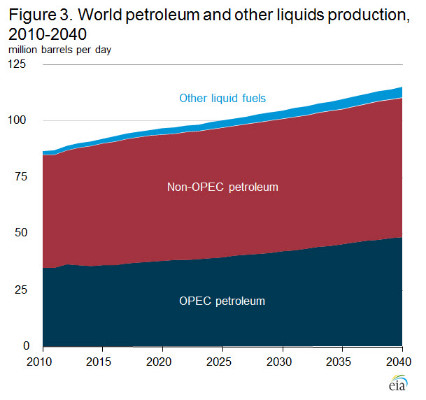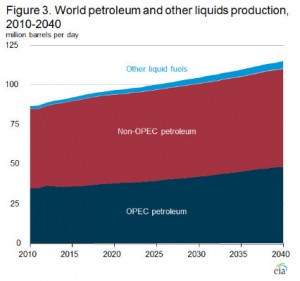
Forecasting the Future: EIA’s International Energy Outlook to 2040
On July 25th the Center for Strategic and International Studies hosted the administrator of the U.S. Energy Information Administration (EIA), Adam Sieminski, on the occasion of the 2013 International Energy Outlook (IEO2013) release. The report contains forecasts of world energy demand by region and energy source, electricity generation by energy source, and CO2 emissions by energy source to 2040, among other critical issues. Sieminski presented major findings from the report.
Coal will remain king in 2040 and the source of the most carbon emissions globally, but certain trends are welcome. The percentage of electricity generated from coal will fall to 36%, and that from natural gas rise markedly to 24%, as nuclear and renewables will share the remainder. China will move from a manufacturing, coal-based economy to a service economy driven more by oil; but it will also account for 40% of global increase in nuclear electricity generation.
OPEC countries will supply about half of all petroleum and other liquid fuels in 2040, notwithstanding the significant tight oil boom underway in the United States now. The U.S. will contribute over 10 million bpd, and Russia—home of the world’s largest recoverable tight oil reserves—will provide over 11 million bpd.
Sieminski also listed major uncertainties that could compromise EIA projections. These included: changing economic relations between the U.S., Europe, and China; the timing of Japan’s recovery from the Fukushima nuclear disaster; social unrest in the Middle East and North Africa; developments in shale gas and tight oil, including new technologies and regulations; OPEC decisions on supply; and climate policies. Sieminski stressed that his agency predicts as accurately as possible given present-day realities and trends.
In fact, the Energy Outlook assumes that many current policies remain in effect. If policies change, outcomes would change accordingly. This implies that if the predictions are troubling—e.g., continued massive CO2 emissions—then advocating for change and implementing new policies could have considerable result.
The IEO2013 also does not address the impact of climate change on global energy demand, though Sieminski did refer to EIA studies on climate change and dangers to the U.S. energy infrastructure. He described a Venn diagram of three overlapping bubbles: energy security, economy, and environment. The “sweet spot” where all three overlap might be natural gas, he suggested.







[…] Forecasting the Future: EIA’s International Energy Outlook to 2040 Warren Dym On July 25th the Center for Strategic and International Studies hosted the administrator of the U.S. Energy Information Administration (EIA), Adam Sieminski, on the occasion of the 2013 International Energy Outlook (IEO2013) release. The report contains forecasts of world energy demand by region and energy source, electricity generation by energy source, and CO2 emissions by energy source to 2040, among other critical issues. Sieminski presented major findings from the report. […]
[…] Forecasting the Future: EIA’s International Energy Outlook to 2040 […]